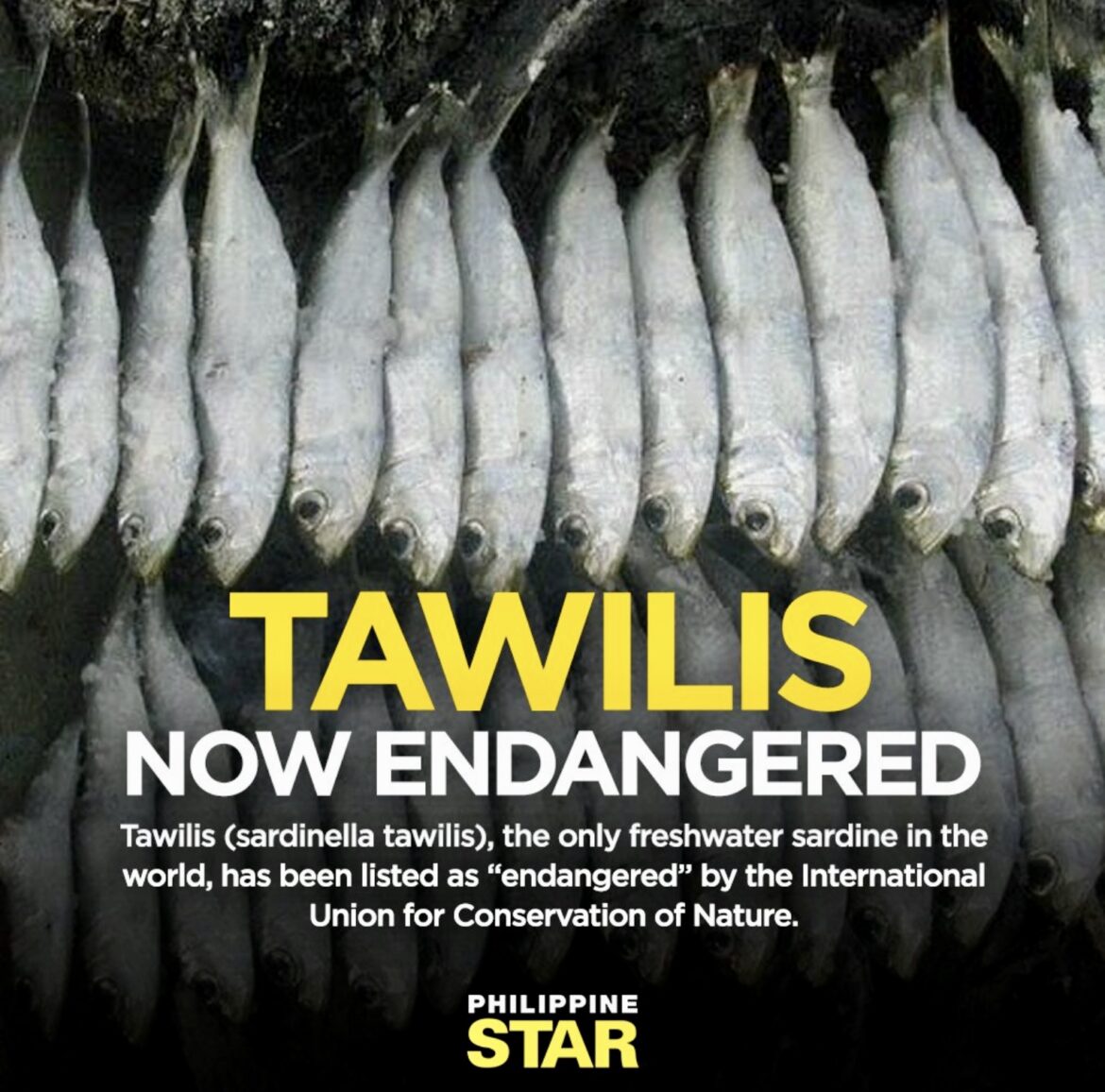By Henrylito D. Tacio
Photos taken from the Twitter of Oceana and Philippine Star
Narra, abaca, pili nut, waling-waling, tamaraw, tawilis, and Philippine eagle. These are just examples of the endemic flora and fauna that thrive in the country. If we don’t watch out, they may soon vanish from this part of the world.
Take the case of tawilis, which may disappear from swimming in the waters of Taal Lake in Batangas. Two years ago, the Switzerland-based International Union for Conservation of Nature (IUCN) included freshwater fish as endangered species.
The basis of the declaration was the studies done by Filipino scientists, according to Jo. Florendo B. Lontoc in an article published on the website of University of the Philippines, up.edu.ph.
Prof. Augustus C. Mamaril of the UP Diliman Institute of Biology was one of those who raised the alarm. He used the lake as a field demonstration and specimen collection site for his biology class since the late 1980s. “The catch was dwindling, and the fish size was smaller and thin,” he was quoted as saying.
Dr. Maria Theresa Mercene-Mutia, of the National Fisheries Research and Development Institute echoed the same concern, stating that the declining catch was “observed through at least 20 years’ worth of research dating back to the 1990s.”
The inclusion of tawilis in the endangered list is a “wake-up call,” to quote the words of Dr. Mudjekeewis Santos of the National Academy of Science and Technology, for Filipinos as tawilis can only be found in the Philippines. “It is also the only known sardine to exist entirely in freshwater,” to quote Oceana Philippines.

In 2018, the Slow Food Foundation for Biodiversity reported that the Ark of Taste International had listed tawilis in the “catalogue of endangered heritage foods of the Philippines.”
“The tawilis is now considered endangered due to overfishing, pollution and predation,” the Marine Wildlife Watch (MWW) in the Philippines said in an infographic that was posted on its Facebook.
A species is considered endangered when it is seriously at risk of extinction.
“(Tawilis) is found in the third largest lake in the country with an area of more than 66,000 hectares and average depth of 60 meters,” said Dr. Rafael D. Guerrero III, a fishery expert who popularized tilapia as the country’s most popular fish after bangus. “The fish was landlocked with the formation of Taal Volcano, about 100,000 years ago, which separated the body of water from the sea.”
Although small, about six- to seven inches long, tawilis is the most dominant fish catch in the lake. The Bureau of Fisheries and Aquatic Research (BFAR), a line agency of the Department of Agriculture, said the fish is caught by gill net, beach seine, ring net, and motorized push net.
We had been to mesmerizing Taal Lake once but unfortunately haven’t tried tawilis. People who have tasted the fish said it is really mouth-watering.
“I love the deep-fried style,” says Dr. Richard T. Mata, a physician from Panabo City who never fails to order tawilis whenever he goes to Tagaytay. “They always say that the beauty of tawilis is that you can eat the whole fish without removing the bones. My son loves it, too.”
In addition to raw consumption, tawilis is also processed into various food products. It is one of the many fish species dried, salted, and sold as daing in the country. They are also smoked and bottled in oil and sold commercially.
Overfishing has been cited as the primary culprit on why it has become an endangered species. “The major cause of the drastic decline in the tawilis catch of the fisherfolk in the lake is overfishing, wherein the rate of human exploitation of the fish surpassed the ability of the fish to replenish itself,” commented Dr. Guerrero, who used to be the director of the Philippine Council for Aquatic and Marine Research and Development.
The MWW reported that the tawilis population has decreased by at least over 50% in the last decade. It said that the reported total catch of tawilis was 1,672 metric tons in 1998. The total catch of the fish dropped to 240 metric tons in 2005 and further dipped to 107 metric tons in 2010.
The use of illegal fishing gear has also contributed to the fish’s demise. “The illegal use of trawlers and ‘superlights’ to attract the fish at night in the past almost wiped out the species,” Dr. Guerrero claimed.
Something must be done to save the tawilis from extinction. Or else, the country will lose an icon culturally, a significant fish historically, and a big loss to Philippine cuisine. “Ecologically, without tawilis, Taal Lake will become less biodiverse, unbalanced, and less resilient to environmental changes,” explains Dr. Arnel “AA” Yaptinchay, MWW founder and director.
Once tawilis is gone from the waters of Taal Lake, it will be gone forever. “If lost, it can never be replaced again,” warns Dr. Yaptinchay.
Several things can be done to keep tawilis from thriving. “Address all the threats simultaneously,” Dr. Yaptinchay suggests. “Government needs to step in and regulate activities in the lake and manage fishing activities by introducing closed seasons for tawilis, and probably even a temporary ban until a non-detriment finding is done.
“More biological and ecological studies should be conducted, especially in culturing the species,” he adds.
Filipino scientists are doing their best to save tawilis from extinction. “The IUCN red-listing was a much-needed boost to the humble tawilis’ plight; but until studies reveal a sustained revival of the fish population, scientists’ work is far from over,” Lontoc concluded.

